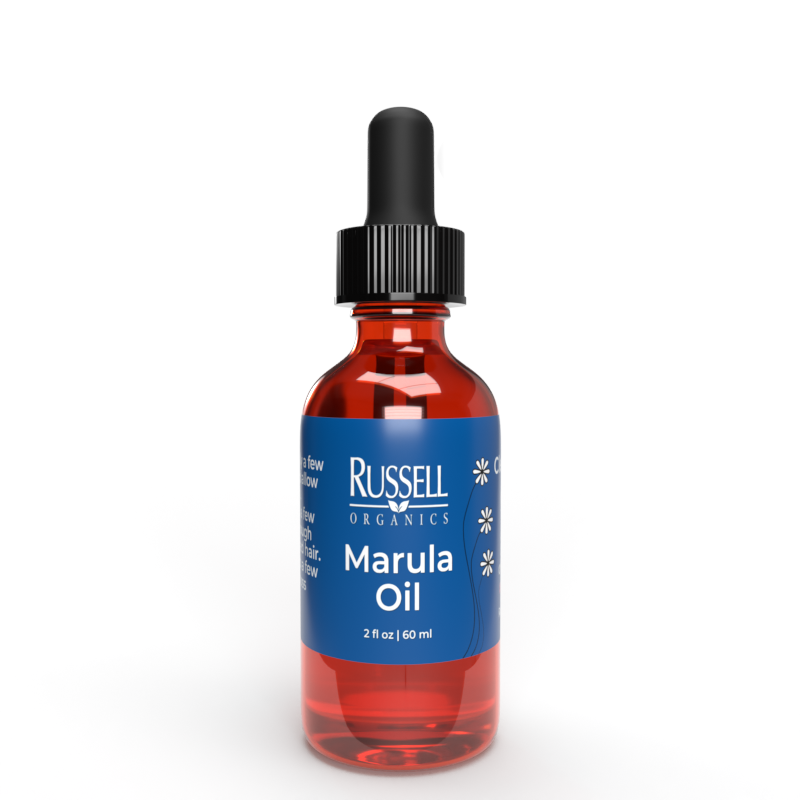
Our Marula Oil has earned its reputation as a certified organic skincare essential and is beloved by those who care for skin, hair, and nails everywhere. Extracted from the nuts of the Marula tree (Sclerocarya birrea) native to parts of Africa, this lightweight oil is rich in essential fatty acids, antioxidants, and vitamins that nourish and protect. Read on for answers to the top Marula Oil FAQs—its benefits, usage tips, and sourcing—so you can harness this golden elixir to its fullest.
________________________________________
1. Can You Apply Marula Oil to Hair?
Answer: Absolutely. Marula Oil is prized for its ability to hydrate, strengthen, and protect hair without weighing it down. See why it’s beneficial and the best application methods:
Ultimate Hydration for Thirsty Hair
• Reason It Works: Loaded with oleic acid (a monounsaturated omega-9) and linoleic acid (an omega-6), Marula Oil penetrates hair strands to lock in moisture and fight dryness.
• Outcome: Hair becomes noticeably softer, smoother, and more manageable.
Smoothing Cuticles for Frizz Control
• How It Works: Marula Oil’s lipids streamline the hair cuticle so strands lie flat to reflect light and reduce frizz.
• Result: Flyaways settle, and hair appears shinier and more uniform.
Healthy Scalp Support
• Essential Component: Featuring vitamin E and plant sterols, Marula Oil promotes scalp health.
• Application: Apply 2–3 drops, gently massaging the scalp to improve blood flow and curb dryness.
• Result: A balanced scalp often translates into less breakage and healthier hair growth.
Protecting Hair from Heat
• How It Works: Apply Marula Oil before heat styling to coat each strand with a protective layer.
• Outcome: This barrier helps minimize the damaging effects of high temperatures, reducing split ends and brittleness over time.
Boosted Hair Resilience
• Benefit: Its fatty acids let strands stretch without breaking.
• Effect: Hair stands up to styling with reduced breakage.
How to Use Marula Oil on Hair
Pre-Wash Mask
• Amount: Apply 1 dime-sized drop for short hair, 1–2 teaspoons for long hair.
• Apply: Massage from the scalp (if needed) through mid-lengths to the tips.
• Work In: Massage lightly to ensure even coverage across scalp and hair.
• Leave on: Let the oil sit for 15–30 minutes.
• Wash Out: Wash hair with your regular shampoo and condition as usual.
Effect: Deep conditioning helps fortify hair, making it softer and easier to detangle.
Post-Wash Treatment
• Damp Prep: Remove excess water so hair is damp but not soaked.
• Warm a Few Drops: Rub 2–4 drops of Marula Oil between your palms.
• Apply to Ends: Work the oil through mid-lengths to ends, steering clear of roots.
• Style as Usual: Gently work a comb through and style.
Outcome: Provides daily moisture, tames frizz, and marula oil lotion seals split ends.
Finishing Touch Serum
• Dot & Smooth: Warm one drop (two if hair is thick) between palms.
• Apply to Frizzy Spots: Sweep lightly over split ends and flyaways.
Outcome: Adds shine and a polished finish.
By incorporating Marula Oil into your haircare routine—whether as a mask, leave-in, or styling serum—you support stronger, more hydrated, and visibly healthier hair without any greasy buildup.
________________________________________
2. Does Marula Oil Block Pores?
Answer: Very unlikely. With a comedogenic rating of 0–1, Marula Oil seldom clogs pores, even for those with combination or oily skin. Reasons Include:
Feather-Light Consistency
• Skin Penetration: Its lightweight nature lets it sink in fast. It won’t leave a greasy film as heavier oils do.
• Result: It nourishes from within, reducing pore congestion.
Harmonizing Skin’s Oil Production
• Lipids & Fatty Acids: With a lipid makeup close to sebum, it helps balance oil levels.
• Benefit: Instead of prompting extra oil, it harmonizes sebum output.
Antioxidant and Anti-Inflammatory Components
• Protective Vitamins: These antioxidants help protect the skin barrier and reduce inflammation—factors that can indirectly help minimize acne flare-ups.
• Natural Phenolics: Phenolic acids soften irritation, making clogged pores less likely.
Avoiding Breakouts
• Apply to Clean Skin Only:
Begin on skin free of makeup, sunscreen, and oil. This ensures you’re not sealing in makeup, sunscreen, or environmental pollutants under the oil.
• Use Sparingly:
Small amounts suffice. Begin with 2–3 drops for your entire face. If you need more for dryness, gradually increase but avoid over-saturating.
• Patch Test First (Especially If You’re Acne-Prone):
Apply a drop to a small patch, wait 24 hours to check for adverse reaction.
• Find the Right Frequency:
o Daily Use: Nightly use is fine for many.
o Alternate Nights or Use as a Weekly Mask: For excess oil or breakouts, try it 2–3 times weekly or as a weekly mask.
To recap, Marula Oil’s lightweight, fast-absorbing nature, combined with a low comedogenic rating, makes it a safe option for most. For highly oily skin, ease in slowly, observe your skin, and tailor frequency.
________________________________________
3. How to Use Marula Oil for the Face
Marula Oil is an adaptable face oil offering moisture, antioxidant power, and a glowing finish with no greasiness. Below is a step-by-step guide to make Marula Oil a powerful part of your skincare routine:
3.1 Choose When to Use It
• Daytime Use (Optional):
o Ideal For: Dry, combination, or mature skin types can benefit from a morning application.
o Why: Gives a luminous, hydrated base for makeup. If you use Marula Oil in the morning, apply sunscreen over it.
o Note: Oily or acne-prone skin may prefer skipping mornings or just using one drop under their cream.
• Evening Use (Highly Recommended):
o Ideal For: Recommended for deep nighttime nourishment.
o Reason: At night, skin renewal peaks and Marula Oil aids this with antioxidants.
o Note: Follow any serums (like retinol or vitamin C) with 3–4 drops at night.
3.2 How to Apply
1. Cleanse:
o Remove makeup, SPF, and daily grime using a gentle cleanser. Pat dry gently; oil adheres better to slightly damp skin.
2. Serum Layer:
o Layer any water-based treatments (e.g., vitamin C, hyaluronic) before the oil. Give it 30–60 seconds to absorb deeply.
3. Prepare the Oil:
o Add 2–4 drops to your clean hands. Rub palms to warm and emulsify the oil for easier application.
4. Press In & Massage:
o Technique:
Press: Lightly press palms to cheeks, forehead, chin, and neck.
Massage: Using gentle upward, circular motions, massage the oil into your skin for about 30 seconds.
o Key Spots:
Areas prone to flaking
Areas with early wrinkles
Sensitive or red-prone zones
5. Layering (Optional):
o Should you need extra hydration, add a light cream over the oil. Typically, Marula Oil functions as the final layer, but feel free to layer if necessary.
6. Finalize with SPF (Morning):
o Always top morning application with SPF, letting it absorb briefly before cosmetics.
3.3 Variations & Tips
• Blend with Cream:
Add a drop to a small dab of cream for extra hydration.
• Targeted Spot Treatment:
Use a single drop on fine lines, scars, or rough patches, massaging gently.
• Weekly Oil Mask:
1. Cleanse thoroughly.
2. Spread 5–7 drops evenly across face.
3. Leave on overnight or for at least 20–30 minutes.
4. Blot or rinse: In the morning, gently blot any excess or rinse lightly and follow with your routine.
o Who: Great for combination or acne-prone skin as a weekly hydration boost.
3.4 Benefits When Used on the Face
• Deep Moisture & Barrier Support:
By sealing in hydration, fatty acids keep skin plump while strengthening its barrier to prevent water loss.
• Free Radical Defense:
Vitamins C and E neutralize free radicals (from UV exposure, pollution, stress). This helps prevent premature aging—fewer fine lines and a more even tone.
• Anti-Inflammatory Relief:
Anti-inflammatory sterols and phenolic compounds reduce redness and irritation. This makes Marula Oil suitable for sensitive or reactive skin types (e.g., mild rosacea, eczema).
• Brightening & Tone Improvement:
With continued use, vitamin C lightens mild pigmentation, resulting in a more balanced skin tone.
• Compatibility with Actives:
Use it under retinoids or vitamin C to reduce dryness and irritation.
By following these steps and tips, you can harness Marula Oil’s full potential—achieving hydrated, radiant, and soothed skin without feeling greasy.
________________________________________
4. What Is Marula Oil Made From?
Answer: Extracted solely from Marula nut kernels, this oil remains unrefined and cold-pressed to preserve its nutrients. Learn how Marula Oil is sustainably sourced, cold-pressed, and bottled:
4.1 Origin of the Marula Tree
• Botanical Name: Sclerocarya birrea, commonly known as Marula.
• Native Regions:
o Southern African Range: Found in South Africa, Namibia, Botswana, and Zimbabwe.
o Eastern Africa: Natural habitats include Mozambique and Tanzania.
• Growth Pattern: These trees grow in natural savannas and woodlands, eliminating plantation-driven deforestation.
4.2 The Fruit & Nut
• Marula Fruit:
o Fruit Appearance: Small, yellow when ripe (about 2–4 cm in diameter).
o Traditional Uses: The sweet pulp is eaten fresh, fermented into beverages, or used in jams.
o Nutritional Value: Rich in vitamin C and antioxidants, prized by animals such as elephants and baboons.
• Nut Inside:
o Nut Shell: Hard, woody exterior.
o Kernel: Inside lies the kernel, containing about 60% oil.
4.3 Harvesting & Processing
1. Fruit Gathering:
o Harvest Season: Late summer, when fruits naturally fall.
o Gatherers: In many African villages, women gather fallen fruit. This traditional practice has been passed down through generations and often takes the form of women-led cooperatives.
2. Shelling & Kernel Preparation:
o Manual Sorting: Workers remove any remaining fruit pulp, then crack open the hard shells to extract kernels.
o Drying: Kernels are spread out in the sun to dry. This reduces moisture content, which helps preserve nutrients and prevents spoilage.
3. Oil Extraction:
o Benefits of Cold Pressing: Applying minimal heat during extraction preserves sensitive nutrients—vitamins, antioxidants, and essential fatty acids.
o Method:
Press Machinery: Cold-press machinery extracts oil under low heat.
Oil Separation: Oil oozes out and is collected in a container beneath
o Advantages: Retains full nutritional profile, flavor, and scent of the oil.
4. Filtering & Bottling:
o Clarifying: The raw oil may contain small particles—dust, kernel fragments, or solids. It is filtered through fine mesh or a cloth to yield a clear, golden liquid.
o Packaging: Dark glass bottles (amber or cobalt) shield oil from UV, safeguarding its potency.
4.4 Nutrient Profile
• Oleic Acid – 70–78%: Serves as a powerful moisturizer by mirroring natural sebum.
• Linoleic Acid (Omega-6): Enhances the skin barrier and locks in moisture.
• Palmitic & Stearic – Minor: Contribute to skin nourishment and softness.
• Antioxidants:
o Vitamin E: Protects against free radicals.
o Vitamin C: Helps build collagen and lightly brighten skin.
• Phenolic Compounds & Sterols: Provide anti-inflammatory, soothing benefits.
With its balanced profile, Marula Oil hydrates, reinforces the skin barrier, and fights aging in a non-greasy formula.
________________________________________
5. Fragrance Profile
Answer: It offers a mild, nutty aroma with a subtle hint of sweetness.
• Nutty Undertones: Because it comes from the kernel of a nut, you’ll notice a faint, mildly nut-like scent. It is subtle—comparable to lightly toasted sunflower seeds or almonds, but far gentler than peanut or coconut oil.
• Soft Sweetness: A gentle sweet note reminiscent of fruit, though never as strong as citrus or berry extracts.
• Fades Quickly on Skin: Once applied, the aroma fades rapidly, unlike lingering essential oils.
o Benefit: Perfect for layering under scented products since it disappears swiftly.
In short, Marula Oil offers a pleasant, light fragrance that isn’t overwhelming and fades quickly, making it a great choice for fragrance-averse users.
________________________________________
6. Best Times to Apply Marula Oil
Answer: You can use Marula Oil morning, evening, as a weekly treatment, or anytime for hair and body.
6.1 Morning Routine (Optional)
• Ideal For: Dry, mixed, or mature skin types who crave extra moisture in the AM.
• Reason: Creates a moisture shield to combat UV exposure, pollution, and chilly wind.
• How to Apply:
1. Cleanse: Use a gentle, non-stripping cleanser.
2. Optional Serum: Use water-based serums first.
3. Dispense a Drop or Two: Rub in palms, pat on cheeks and eye area.
4. Finish with SPF: Always top with sunscreen.
• If Acne-Prone: Those prone to breakouts: either skip am use or apply just half a drop under cream.
6.2 Nighttime Routine (Recommended)
• Who: Perfect for dry, reactive, or mature skin types.
• Reason: At night, cell turnover accelerates; oil aids repair with fatty acids and antioxidants.
• Method:
1. Remove Makeup & Cleanse: Use an oil cleanser followed by a gentle wash.
2. Optional Actives: Layer serums like retinol or vitamin C, then wait briefly.
3. Warm 3–4 Drops: Distribute on cheeks, T-zone, and neck
4. Massage In: Use upward, circular movements for 30–60 seconds to stimulate circulation and absorption.
• Add Night Cream: Feel free to use a rich cream over the oil if needed for dry skin.
6.3 Once-a-Week Hydration Mask
• Who: Great for reactive or oily skin types who want all the benefits but not every day.
• Why: Gives skin a deep boost of hydration without daily layering.
• Method:
1. Cleanse Thoroughly: Remove makeup, oil, and product residue with a gentle cleanser.
2. Dispense 5–7 Drops: Gently pat all over face.
3. Leave on for 20–30 Minutes: Keep on for at least 20 minutes or overnight.
4. Blot Excess or Rinse: Blot with a soft cloth or rinse lightly if too oily.
6.4 Anytime for Hair & Body
• Haircare:
o Deep Pre-Wash Treatment: Massage 2–3 tablespoons into dry hair and scalp. Leave for 20–30 minutes, then shampoo and condition.
o Post-Shower Hydration: Use 1–2 drops on towel-dried hair, focusing on ends.
• Bodycare:
o Rough Areas: Rub into dry patches like elbows, knees, and cuticles
o Scar & Mark Treatment: Massage a drop onto scars or stretch marks daily to support tissue regeneration and improve elasticity.
• Special Uses:
o Gentle Cleanser: Apply onto a cotton pad to remove makeup, rinse or follow with your cleanser.
o Nail Care: Use one drop per nail to soften and nourish cuticles.
Knowing when to use Marula Oil—AM, PM, weekly, or any time—lets you tailor its use for your unique skin and hair regimen.
________________________________________
7. Origins & Ethical Harvesting
Answer: Marula Oil is sourced from the kernels of the nut enclosed in the fruit of the Marula tree (Sclerocarya birrea). Below is a closer look at its origins, how it’s harvested, and why this matters:
7.1 Geographic Origins
• Marula Tree Habitat:
o Southern Africa: Native to South Africa, Namibia, Botswana, and Zimbabwe.
o Eastern Range: Mars in Mozambique and Tanzania.
• Environmental Note: Unlike plantation crops, Marula trees grow in the wild, reducing deforestation pressure.
7.2 Community & Culture
• Harvest Season: After ripening in late summer, the fruit falls to the ground and is collected by local communities.
• Pulp vs. Nut Usage:
o Fruit Pulp: Eaten fresh, turned into fermented beverages called “amarula” (not to be confused with the cream liqueur), or used in jams.
o Nut Inside: Inside, a hard-shelled kernel holds about 60% oil, which becomes Marula Oil.
• Kernel Processing: Kernels are removed and sun-dried to lower moisture, preserving nutrients and preventing spoilage.
• Oil Extraction Method: Cold-pressing under low temperatures ensures vitamins and lipids remain intact.
• Community & Economic Impact:
o Women’s Cooperatives: Many producers partner with local cooperatives that ensure fair wages and support community projects like schools, wells, or healthcare.
o Environmental Benefits: These trees support wildlife diets and curb soil erosion, bolstering local habitats.
7.3 Quality & Sustainability
• Wild Harvesting vs. Plantation Farming: Because it’s wild-harvested rather than farmed, Marula Oil prevents large-scale deforestation.
• Certifications to Look For:
o Organic: Certified organic, guaranteeing no synthetic chemicals.
o Fair Trade: Confirms ethical pay and safe work environments.
o Non-GMO: Assures kernels are non-genetically modified.
Choosing ethically sourced Marula Oil supports tradition, community, and the environment.
________________________________________
8. Purchasing Guide
Answer: Finding authentic, high-quality Marula Oil can be challenging because some products on the market may be diluted or mixed with cheap fillers. Use these tips to ensure you get real, potent Marula Oil:
8.1 Trusted Retail Channels
• Brand Direct:
o Example: Purchase directly from the Russell Organics website to ensure you receive a 100% pure, certified organic, vegan, cruelty-free, and clean-beauty Marula Oil.
o Direct sources typically share batch testing and sourcing data for transparency.
• Specialty Beauty Retailers:
o Trusted e-tailers such as Sephora, Dermstore, Cult Beauty, and Credo stock premium, certified Marula Oil.
o Find reliable reviews, ingredient verification, and authenticity checks on these sites.
• Health-Focused Markets:
o Whole Foods, Trader Joe’s, Local Co-ops: Some carry small brands specializing in ethically sourced oils.
o Look for “cold-pressed” and “organic” labels.
• Boutique Beauty Boutiques & Spas:
o High-end beauty boutiques usually carry authentic artisan oils with knowledgeable staff.
• Amazon (With Caution):
o How to Shop Safely:
Verified Sellers: Buy directly from Russell Organics’ Amazon store or verified distributors.
Check Labels: Verify the label reads “Pure Cold-Pressed Marula Oil” and shows certifications.
Pricing: If the price is unusually low (e.g., under $15 for a 1-ounce bottle), be skeptical—high-quality Marula Oil generally costs $25–$50 per ounce.
8.2 What to Look for on the Label
• Pure Marula Oil Label: No other oils, fragrances, or additives should be listed. If any other oil (e.g., sunflower, soybean) appears, it’s not a pure Marula product.
• Extraction Method: Indicates minimal heat was used, which preserves the oil’s nutrients.
• Dark Glass Bottle: Amber or cobalt blue bottles protect the oil from UV light, which can degrade its potency.
• Trust Seals:
o Organic Seals: Confirms no pesticides or synthetic fertilizers.
o Fair Trade / Rainforest Alliance: Ensures cooperatives and communities are supported.
o Non-GMO: Assures kernels are not genetically modified.
• Traceability: Allows you to trace the specific production batch in case of recalls or to verify quality-testing results.
8.3 Cost & Quality Alerts
• Typical Price Range: Expect $25–$50 for a single ounce of authentic Marula Oil.
• Watchouts:
o Under $20/ounce: Often indicates a blend with cheaper oils.
o Opaque or Plastic Bottles: Plastic containers may leach chemicals, and opaque bottles prevent you from checking clarity and color.
o No Sourcing Info: If the brand offers no details on sourcing or processing, proceed cautiously.
By purchasing from reputable sources, checking labels carefully, and being mindful of pricing, you can feel confident that your Marula Oil is pure, potent, and ethically produced.
________________________________________
9. What Makes Marula Oil Excellent for Skin
Answer: It combines intense hydration, free-radical defense, and calming effects—all in a non-greasy fit. Here’s why it shines as a skin care superhero:
9.1 Ultra-Moisture & Barrier Repair
• Oleic Acid (Omega-9): Penetrates swiftly to quench skin, leaving it plump and soft.
o Result: Dry patches vanish, revealing a hydrated, resilient glow.
• Linoleic Acid (Omega-6): Bolsters the lipid barrier for long-lasting hydration.
o Effect: A fortified barrier means fewer irritations and softer skin.
9.2 Antioxidant Protection
• Vitamin E (Tocopherol): Protects collagen and elastin fibers against environmental damage.
o Effect: Helps maintain firmer, smoother skin by countering oxidative stress.
• Vitamin C: While present in smaller amounts, it assists collagen production and inhibits excess melanin production.
o Result: Brighter, more even complexion over time; reduced appearance of mild hyperpigmentation.
• Phenolic Compounds & Sterols: Provide additional free-radical scavenging and anti-inflammatory benefits.
9.3 Calms & Comforts
• Plant Sterols: Help calm irritated skin by supporting barrier function.
o Effect: Soothes inflammation for a calmer complexion.
• Anti-Inflammatory Phenolics: Further soothe inflammation and promote gentle healing.
9.4 Youthful Radiance & Repair
• Barrier Repair & Collagen Support: By providing essential fatty acids and antioxidants, Marula Oil helps preserve and protect existing collagen and elastin fibers.
o Result: Reduced appearance of fine lines and wrinkles, firmer skin over time.
• Hydration & Plumping: Moisturized skin looks visibly plumper.
o Result: Wrinkles appear less pronounced when fully hydrated.
9.5 Safe for Most Skin Types
• Low Comedogenic Score: Suitable for nearly all skin types due to its low pore-blocking rating.
o Effect: Use nightly with minimal breakout risk.
• Great for Reactive Skin: Pure, unrefined Marula Oil rarely triggers irritation.
o Result: Even those with sensitive or reactive skin often find Marula Oil calming rather than irritating.
9.6 Brightening & Tone Improvement
• Vitamin C’s Role: Gradual brightening and evening of skin tone thanks to vitamin C.
o Result: Pigment irregularities soften with consistent use.
9.7 Scar & Stretch Mark Support
• Enhanced Circulation: A gentle daily massage with Marula Oil can stimulate circulation, promoting tissue regeneration.
o Effect: Old scars and stretch marks soften over time with consistent use.
• Moisture & Elasticity: By keeping skin well-hydrated, the oil prevents further tearing of compromised tissue (important for stretch marks)
o Effect: Skin feels more supple, reducing the visibility of old scars or marks over time.
9.8 Versatility Across Age Groups
• Young Skin Benefits:
o Oil Control: Spot-treat oily areas to reduce breakouts.
o Benefit: Minimizes overcompensation by the skin (producing excess oil when stripped), reducing breakout frequency.
• Early Adulthood (20s–30s):
o Prevention: Antioxidants preserve youthful bounce and ward off premature aging
o Benefit: Defers signs of aging through antioxidant protection.
• Mature Skin (40s+):
o Deep Nourishment: Deeply nourishes to combat thinning barrier and dryness
o Effect: Skin regains firmness and looks more youthful.
By delivering hydration, antioxidant defense, soothing relief, and gentle brightening without clogging pores, Marula Oil earns its place as a multi-functional skincare essential.
________________________________________
10. Source & Composition
Answer: Marula Oil is extracted exclusively from the kernels (seeds) found inside the hard nuts of the Marula fruit. Rather than being distilled or solvent-extracted, it is cold-pressed—a process that preserves its natural vitamins, antioxidants, and fatty acids. Here’s a concise overview of its journey from tree to bottle:
• Marula Tree & Fruit:
o Scientific Name: Sclerocarya birrea.
o Fruit Characteristics: Round, yellow fruit with a hard shell and seed(s) inside.
• Kernel Removal:
1. Harvest: Local communities collect fallen fruit in late summer.
2. Cracking the Nut: Crack shells to separate kernels.
3. Drying: Kernels are left to dry under the sun to reduce moisture and preserve nutrients.
• Cold-Pressing & Filtering:
1. Oil Press: Cold mechanical pressing yields nutrient-rich oil without heat damage.
2. Filtering: Filtering removes fine particles—dust, solids—leaving a clear, golden liquid.
• Bottling: This unrefined oil is poured into dark amber or cobalt blue glass bottles to shield it from UV rays that can degrade its components over time.
Nutrient Highlights:
• Fatty Acids: Moisturizing and barrier-repairing fatty acids.
• Antioxidants: Vitamins E & C defend against free radicals.
• Soothing Agents: Skin-calming phenolics and barrier-supporting sterols.
From kernel to bottle, careful processing preserves Marula Oil’s rich nutrient mix.
________________________________________
11. Aroma Highlights
Answer: Expect a gentle nutty scent with a light sweet whisper that vanishes soon after application. Its quick fade and mild scent make it ideal for those who tolerate little to no fragrance.
________________________________________
12. Source Summary
Answer: Harvested from wild Marula trees in Africa, this oil’s production—led by women’s cooperatives—fosters sustainable practices and community empowerment.
________________________________________
13. Sourcing Guide
Answer: Purchase from reputable channels to ensure authenticity. Look for it at:
• Official Brand Website: Russell Organics (certified organic, vegan, cruelty-free)|
• Curated E-Tailers: Sephora, Dermstore, Cult Beauty|
• Natural Food & Wellness Stores: Whole Foods, local co-ops|
• High-End Boutiques: Artisan or small-batch vendors|
• Amazon Shopping: Only from verified sellers, with “100% Pure Cold-Pressed Marula Oil” and proper certifications|
Ensure it’s pure, cold-pressed, in dark glass, and certified organic or Fair Trade. Pricing should be around $25–$50/ounce; be wary of anything under $20.
________________________________________
14. Why Is Marula Oil Good for Skin? (Recap)
Answer: Its unique blend of moisturizing fatty acids, vitamins, and soothing agents makes Marula Oil ideal for healthy, glowing skin. Whether you aim to preserve youthful skin, combat dryness, or soothe sensitive areas, Marula Oil’s balanced composition makes it an excellent, multi-functional skincare choice.
________________________________________
Marula Oil solves myriad beauty needs—hydrate and strengthen hair, deliver light, non-comedogenic hydration to the face, and soothe body. Harvested ethically from African Marula kernels, it’s cold-pressed into a nutrient-rich, fast-absorbing oil with a soft nutty scent. Use morning, evening, once weekly, or whenever you or your hair needs it. Look for certified, pure Marula Oil in dark glass packaging to ensure potency, and relish its complete nourishing and protective effects
 Alfonso Ribeiro Then & Now!
Alfonso Ribeiro Then & Now! Ariana Richards Then & Now!
Ariana Richards Then & Now! Michelle Trachtenberg Then & Now!
Michelle Trachtenberg Then & Now! Tonya Harding Then & Now!
Tonya Harding Then & Now! Sarah Michelle Gellar Then & Now!
Sarah Michelle Gellar Then & Now!